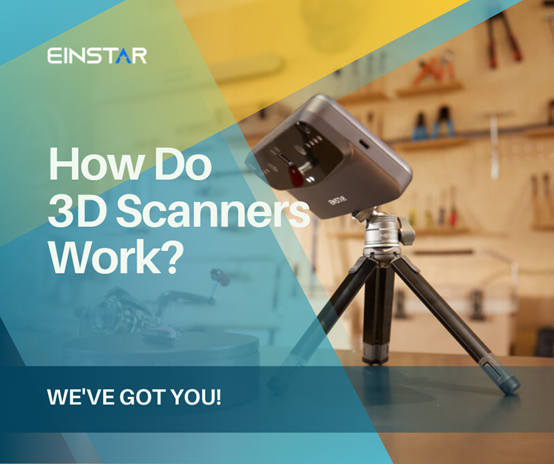Have you ever been surprised by how a real-world object, that intricate sculpture, a classic car part, or even your favorite coffee mug, can be perfectly replicated as a digital model on a computer screen? It feels a bit like magic, doesn't it? We see the physical item right in front of us, and somehow, a 3D scanner transforms it into a digital blueprint.
This fundamental curiosity, "how do 3D scanners work?", is exactly what we're here to explore. Forget the complex jargon for a moment; we're going to break down the fascinating process by which these devices capture every curve, contour, and detail, translating tangible objects into editable, virtual assets. Get ready to explore the ingenious technology that bridges the gap between the physical and the digital!
3 Minutes to Learn the Very Basics About 3D Scanning – What is 3D Scanning, Point Cloud & Meshes
At its heart, what is 3D scanning? It's a non-destructive technology that precisely captures the shape and, often, the appearance (like color or texture) of a physical object or environment. Think of it as creating a three-dimensional digital photograph.
The journey from a physical object to a digital model involves two key output forms:

The Raw Data: Point Clouds
When a 3D scanner (except for some industrial 3D scanners that support meshes generation) "sees" an object, it doesn't immediately create a perfect, solid model. Instead, it captures millions of individual measurements, each representing a tiny point on the object's surface in three-dimensional space.
This raw data forms what's known as a scanner point cloud. Imagine a vast constellation of dots, where each dot has a precise X, Y, and Z coordinate. This point cloud holds all the geometric information of the scanned object, providing an incredibly detailed, albeit unstructured, representation.
Building the Surface: Meshes
While a point cloud gives us the raw spatial data, it's not a ready-to-use 3D model for most applications. To transform this collection of discrete points into a solid, usable digital object, specialized software connects these points to form a mesh.
A mesh is essentially a network of interconnected vertices (points), edges (lines connecting vertices), and faces (usually triangles or quadrilaterals) that together define the continuous surface of the object. This meshing process creates a watertight or unwatertight (The watertight model is intended for 3D printing and unwatertight model is more for future editing), editable 3D model that can be easily manipulated, textured, or prepared for processes like 3D printing.
3D Scanning and Imaging Process
So, the fundamental 3D scanning and imaging process can be visualized as a clear progression:
Physical Object → A Point Cloud Representation → A Final Mesh Model
This transformation is the essence of non-contact metrology and lays the groundwork for bringing the physical world into the digital one.
3D Scanner Types Categorized by 3D Data Acquisition Methods
Just as our eyes perceive the world in different ways depending on light conditions or our focus, 3D scanners employ various methods to capture the geometry of an object.
These methods fall into two primary categories based on how they interact with the object: Contact Scanning and Non-Contact Scanning.

Source: https://www.einscan.com/applications/3d-scanning-101-all-you-should-know-about-3d-scanning-2/
Contact Scanning: The Touch-Based Approach
As the name suggests, contact scanning involves physically touching the object's surface to measure its dimensions. These systems typically use a probe or stylus that moves across the object, recording precise coordinates at each point of contact.
While contact scanners offer exceptional accuracy, particularly for defined points, they can be slower and might not be suitable for delicate or deformable objects.
Non-Contact Scanning: Measuring Without Touching
Non-contact scanning methods capture data without any physical interaction with the object. They can scan a wide range of materials and applications. This broad category can be further divided:
Passive Non-Contact Methods
Passive methods do not emit any energy (like light or sound) themselves. Instead, they rely on ambient light or existing energy emitted by the object. While not "scanners" in the traditional active sense, they are crucial for 3D reconstruction and creating 3D models. Passive non-contact also has its branches stemming from “Shape from X”, but it is not the focus today.
Active Non-Contact Methods
Active types of 3D scanners emit their own energy (light, laser, sound, X-rays) and then analyze how that energy interacts with the object to determine its shape. These are the most common and versatile 3D scanning technologies.
For 3D scanners used in common projects, optical active plays the main role. So, in the next section, let’s detail this type of 3D scanner.
Know the Technology Used in the 3D Scanners at Hand – Active Optical
Active optical 3D scanners are distinguished by their use of light – be it laser, structured patterns, or pulsed beams – to illuminate an object and capture its geometry. The way this light interacts with the surface and is observed by a camera forms the basis of 3D data acquisition.
1. Laser Light 3D Scanning: Precision Through a Point or Line
One of the earliest and still highly effective active optical methods involves laser light.
Principle
Laser scanners typically project a single laser dot or a laser line onto the object's surface. A camera, positioned at a known offset from the laser emitter, observes the position of this dot or line.
Because the camera and laser are separated by a fixed distance (the "baseline"), any distortion or displacement of the laser's path on the object's surface allows the system to calculate the exact distance to that point using trigonometric principles, hence, triangulation. As the laser moves across the object or the object rotates, millions of these distance measurements are collected to form the scanner point cloud.

Applications
Laser scanners are renowned for their high accuracy and ability to capture intricate details. They are widely used in quality control, reverse engineering, inspection of industrial parts, and even cultural heritage preservation, where precision is paramount.
2. Structured Light 3D Scanning
Perhaps the most common and versatile active optical method for general-purpose scanning, especially for objects that fit on a desktop or require quick capture, is structured light 3D scanning.
Principle
Unlike a single laser point, a structured light 3D scanner projects a known pattern of light onto the object's surface. This pattern can be anything from simple parallel lines to complex grids or random dot arrays.
A camera captures how this projected pattern deforms or distorts as it falls over the object's contours. Just like with laser triangulation, the system analyzes these distortions to calculate the depth and shape of the surface, creating a highly detailed 3D reconstruction.


Light Patterns/Technologies within Structured Light
-
Phase Shift: Projects a series of patterns that shift in phase (like waves). By analyzing how these phase shifts are distorted, these scanners can achieve incredibly high accuracy and dense point clouds, often down to microns.
-
Multi-Line: Projects multiple parallel lines simultaneously onto the object. It allows for faster data capture compared to single-line scanning, making it efficient for handheld 3D scanners for 3D printing or quickly scanning larger areas.
-
Speckle (or Random Dot/Coded Light): Projects a random pattern of dots or a unique "coded" light pattern onto the object. This allows for very fast capture rates, making it suitable for handheld scanning where movement is involved, as each captured frame contains enough unique information for triangulation.
The projection of these intricate light patterns relies on sophisticated display technologies:
-
Digital Light Processing (DLP): Often found in projectors, DLP chips contain millions of tiny mirrors that can be individually tilted to create and project the precise light patterns required for structured light scanning.
-
Diffractive Optical Elements (DOE): These are optical components that can split or shape a single light beam into a specific pattern, like a grid or an array of dots, without the need for complex digital projection.
-
VCSEL (Vertical-Cavity Surface-Emitting Laser): While a type of laser, VCSEL arrays are increasingly used in structured light systems, particularly for speckle patterns, due to their efficiency, compact size, and ability to emit multiple laser beams simultaneously.

3. White Light & Blue Light
Within structured light scanning, you'll often hear about "white light" and "blue light" scanners.
-
White Light: Traditional structured light scanners often use white light, which is broad-spectrum.
-
Blue Light: Many modern structured light scanners use blue light. This is because blue light has a shorter wavelength, which can lead to higher resolution and more accurate data capture, particularly for darker or more challenging surfaces. Blue light also reduces interference from ambient light, improving accuracy in varied environments.
4. Time-of-Flight (ToF) 3D Scanning
ToF scanners emit a pulse of light (often infrared) and then measure the exact time it takes for that light pulse to travel from the scanner, hit the object's surface, and return to the scanner's sensor.
Where to Begin Your 3D Journey
For beginners and professionals seeking a reliable, versatile, and user-friendly entry point into this exciting field, we highly recommend exploring EINSTAR portable 3D scanners.
EINSTAR embodies the cutting-edge of structured light technology, offering an exceptional balance of resolution, speed, and ease of use in a compact, handheld design. It's designed to make high-quality 3D reconstruction accessible, allowing you to capture detailed scanner point clouds that seamlessly transform into vibrant, usable 3D models.
Ready to turn your physical objects into digital masterpieces?
Discover the power and versatility of EINSTAR and start your 3D scanning journey today!
Explore EINSTAR Portable 3D Scanners Now!









Share:
Last Guide to 3D Print File Type You’ll Ever Need
How can I obtain EXModel license